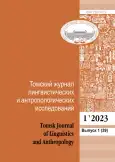The article deals with the vocabulary of folk games in the Eastern dialect of the Mari language: Malmyzh, Kungur, and Krasnoufimsk subdialects. Games studied include dice, tip-cat, and a variation of skittles game (in which a stick is thrown at a piece of wood impaled on a stake twisted into the ground). The research is based on Russian and foreign publications on the Mari language, folklore, ethnography, and archival and modern field data, which are being put into scientific circulation for the first time. The main research method is comparative: the words in question are compared with the vocabulary of folk games in the dialects of Mari, Russian, and other Finno-Ugric languages. The Mari dialects studied in the article (in the north of the Mari region) are strongly influenced by the local Russian dialects, while the Mari dialects of the southern region experience a stronger Turkic influence and borrowings from Chuvash and Tatar languages predominate in their vocabulary for folk games. The article deals with the names of playthings (pieces of wood) and the names of games with them (chinok, chizik, chizhik, baklanom, plishka, panok, peshki, shishka, shorchok, sholchok, kapke, babki), as well as with the verbs galitlash, galitlyktash ‘to play a difficult role in the game’. Most of these lexemes are not included in the Mari dictionaries. Some of them are not so much borrowings as the result of changing codes in the situation of Mari Russian bilingualism, especially since some words (baklanom, plyshka, shishka, peshki) were used by Mari informants when they told Russian ethnologists about Mari games in Russian. Thus, the Mari speak local Russian dialects and represent specific local Russian folk game terminology. The Russian words in the Mari language revealed in this article are also found in other Finno-Ugric languages of the Volga-Ural region: Mordovian, Udmurtian, Komi, and Chuvash.
 9-16
9-16


 17-28
17-28


 29-42
29-42


 43-54
43-54


 55-72
55-72


 73-85
73-85


 86-101
86-101


 102-117
102-117


 118-126
118-126


 127-140
127-140


 141-155
141-155











